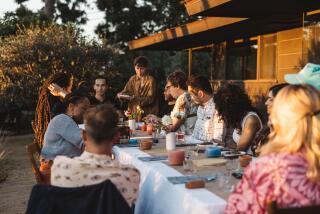Club’s Legacy Is Growing, but Its Membership Is Shrinking
Hard as it is to accept in time of uncertain war, domestic life goes on, as our President has said it should.
And nowhere would it seem more fitting than at the Tuesday Afternoon Club, whose halls resounded with the gaiety of 1,400 women during the Tuesdays of World War II, each playing the role given her during that great event.
Thirty-six of the women who sustain the Tuesday Afternoon tradition were present this week. It wasn’t a regular meeting, which falls on the second Tuesday of each month, but a ways and means affair, said the club’s two-term president, Mrs. E. J. Willmering, or just Irene. She first served 12 years ago, and her turn has come again.
“You’ve heard of recycling?” she said, getting right to the point of her status and the club’s. “This is recycled president.”
As the women, all elderly or nearly so, arrived, paid for their tickets and took their seats, she put aside her official duty to tell me the story of the club.
It started with a birthday tea party in 1898 that became a regular occasion for more and more women. In 1904, they organized as a club. In 1908, they received a state charter as a literary, social, educational and cultural club. The clubhouse at Central Avenue and Lexington Drive was completed in 1925.
In the early years, the women put their energies together to found the city’s first library and help form the symphony orchestra.
The club peaked during the war when, its president said, women “couldn’t get out of town.” It retained enough vigor through the next three decades to rebuild two blocks to the south, when Glendale Savings bought the original clubhouse in 1975 to expand.
Though the club’s legacy has grown ever stronger in the public libraries and the symphony, the club itself is now distinctly on the wane. For lack of juniors, its junior program was abandoned. New members are not being found.
“We’d like to,” Willmering said. “But the problem seems to be everybody is working. Glendale is so saturated with volunteer groups. It’s hard to get people to come into something like this.”
Last spring, with membership down to about 130, the club changed its bylaws, allowing husbands to become members. Three joined.
“Sounds like a doomsday thing,” Willmering said, smiling painfully but not in resignation.
Club life, she said, still revolves around philanthropy, education and society. The women give seven scholarships a year, meet for bridge every third Monday and hold programs in nine departments, from Musicale Theatre Arts to Current Interest and Book Review.
Returning to her duty, the president left me with the scrapbook from her first term.
It was filled with photos and newspaper clippings recalling the club’s past.
“Picture Glendale back in the unhurried, unworried world of 1904,” began a retrospective by Glendale News-Press columnist Wanda Owen.
“The city with its orange groves and sparkling clean air was a bedroom community, pushing for 300 residents, including children. . . . There was one store, one church, a livery barn, a blacksmith shop and one meat market.
“There were homes, though, and fathers and mothers and children. Even in 1904, Glendale had a charm all its own.”
Four years later, the young city had grown to 2,000. But, in another anniversary retrospective, Owen didn’t have much new to add.
“The livin’ was easy in Glendale 70 years ago. . . . “ she wrote. “There were one funeral director, two drugstores, two bakeries and one bookstore in town. . . . There were two hotels, two boardinghouses and seven churches in the city that year--the year the Tuesday Afternoon Club received its charter.”
By the time I had finished with the book, the women, seated four to a card table, had eaten lunch. Before the program began, the program chairman, Mrs. Jake Main, asked if the president had anything to say.
“Not a thing,” Willmering replied.
The program, called “A Furry Fantasy,” was a fashion show by two women who restyle old furs.
“Some of you have probably seen this show before,” said Pat Gault, owner of PAGS of Malibu. “If you have, just take a little nap. We’ll wake you up when it’s over.”
But the audience remained intent as Gault and her partner modeled dozens of minks, foxes and martens that they had reshaped from their original over-extravagance into cute little vests, cuffs, hats and purses in knit and leather combinations.
With patches of Velcro, they even devised practical uses for the heads and tails that, Gault noted, had so pleased the Vanderbilt ladies.
“If you happen to be skiing, take the fur tails and hook them together and you have a hat,” Gault said. “Just have to have a little imagination and a little fun.”
Afterward, the women gathered around the speakers and fur rack.
Most of them, it seemed, did have a few fur treasures at home, things retained from a time when women used their husbands’ names, talked literature over tea, and gave their time and money to an ideal of the community good.
You can still picture Glendale as an unhurried, unworried world: every second Tuesday at the club.



